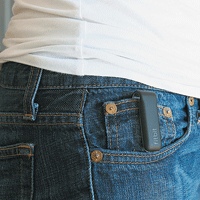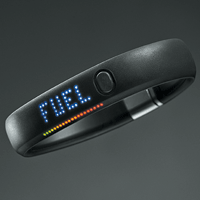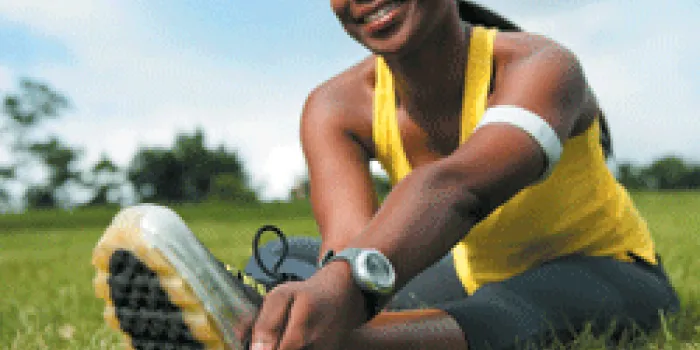Update, October 2014: The US Consumer Product Safety Commission is requiring Fitbit Flex products to warn consumers about the incidence of allergic contact dermatitis, an itchy rash. The warning will mention purchasing the proper size wrist band and that the product contains nickel and other allergens. In February, 2014, the company recalled more than a million Fitbit Force bands, which also contained nickel and methacrylates, chemicals in the adhesives, that can cause skin allergies. To register for a refund go to: www.fit.com/forcesupport.
Original article: Michael Birmingham, 49, got the Fitbit Ultra, in February. The Tacoma, Washington-based IT specialist, who has severe hemophilia A, won the $99.95 device as a prize at a work-related event and has used it for six months. “It tracks me throughout the day,” Birmingham says. “If I have been sitting at the computer too long, it will tell me I have to get up and get moving.”
Birmingham’s favorite feature is Fitbit Ultra’s Active Score. A measurement of overall activity, it gives Birmingham a sense of how much he’s doing during the day. If it’s high, he can rest easy, but a low score tells him he needs to hit the path that circles his office building and do some more walking.

Fitbit Ultra
The Fitbit also has a smart pedometer, which not only counts the number of steps you take in a day but also the number of stairs you climb. It measures the calories you burn, and, if you wear it to bed, its built-in accelerometer tracks how much you toss and turn during the night versus how long you lie still (a sign of quality sleep). Then it automatically uploads that information to your online account on your computer, creating a graph of your sleep patterns.
Through your online account, you can also enter the food you’ve eaten and exercise type, like working out on a stationary bike, and duration. Fitbit takes the data and converts it into colorful, easy-to-read charts that you can use to track progress and set goals. “I can chart everything on a graph and see how I have done over the past 30 days,” says Birmingham. “If I have missed my goal on certain days, I can try to make it up.”
The Fitbit has its share of drawbacks, says Birmingham. For instance, the pedometer does not measure his distance accurately. “I have had both ankles replaced, and so I walk unevenly,” says Birmingham. “That might be what causes the inaccuracy.”
Birminghan has lost—and then found—his Fitbit three times because the belt-holster was not secure. Now, he keeps it in his pocket. Still, if he lost his current one, he would buy another. “It’s money well spent,” he says.
Device Options
The BodyMedia® FIT CORE is another high-tech workout aid. Unlike the Fitbit, which can be dropped in a pocket, the BodyMedia must be worn on the upper arm. There, via skin sensors that measure body temperature and perspiration and an accelerometer that tracks movement, it collects data—calories burned, sleep efficiency, overall exercise level—that can be uploaded to its Web site. Users pay a $6.95 monthly subscription fee in addition to the device’s $119 retail price.

Nike+ FuelBand
A popular alternative is the $149 Nike+ FuelBand, which users wear like a bracelet. The black, rubberized band sports an on-the-go dot-matrix readout of calories burned and activities performed. The display shifts from red to green as you approach your daily goal. The device also converts your activities into Nike Fuel, a point system that allows you to check your daily score against previous days—and against the scores of other users via the Web site. You can wear the unobtrusive device just about anywhere, except the pool. It’s water resistant but not waterproof. With the free iPhone app (sorry, no Android version yet), you can set daily goals and watch the display go from red to green as you approach your finish line. With the included software, you can also compare days, weeks and months to spot trends like mid-week slumps that you can then work to correct.
Safety First
Many of Megan Behr’s clients benefit from the diet-tracking features of high-tech devices like Fitbit in addition to the exercise tools they offer. “Most people don’t realize how much sodium they are consuming, for example,” says Behr, an independent certified personal trainer based in Dallas. “And they think that if they run three miles, they are burning enough calories to let them eat whatever they want.”
These devices help users see the error of their ways and assist them in developing and sticking to a diet and exercise plan, Behr says. But she cautions that although the devices can tell you how strenuously you’ve worked out, they can’t tell you which workout is best or how to do the exercises correctly. “They can’t monitor your form or tell you if you are properly stabilizing your joints,” Behr says. “You need to know those things in order to exercise safely and beneficially.”
That’s why having a physical therapist (PT) is vital for people with bleeding disorders. “You need to get advice from your therapist about whether a certain exercise is appropriate for you,” says Joel Lee, PT at the Hemophilia Treatment Center at University of Iowa Hospitals and Clinics in Iowa City.
Once you have established a proper workout, your device can help you and your PT track its effectiveness, he says. “To sit down with a patient and go over the log their device provides would be very helpful,” says Lee. “Then we may be better able to decide whether to stick with it or advance to the next level.”

